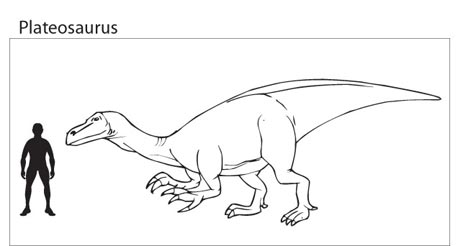Plateosaurus – The Naming of “Flat Lizard”
With the start of the Autumn term, team members at Everything Dinosaur get the chance to go into schools to conduct experiments and explain some of the things we know (and some of the things we don’t know) about dinosaurs.
Plateosaurus
During one such dinosaur teaching session this week, we were asked by an inquisitive eight year old, how did Plateosaurus get its name? Plateosaurus (pronounced plat-ee-oh-sore-us), was one of the first dinosaurs to be formally named and described, although it was not ascribed to the Order Dinosauria by Sir Richard Owen at the time that the term Dinosauria was first used This was due to the fact that those fossils that had been studied were fragmentary and a complete picture of this plant-eating dinosaur had not yet emerged.
Plateosaurus was a large herbivorous dinosaur, perhaps one of the first large herbivores to evolve. Its fossils have been found in numerous locations in western Europe. Growing up to eight metres in length and weighing more than an Indian elephant, this Triassic plant-eater was one of the largest land animals ever to walk the Earth up to around 200 million years ago.
An Illustration of Plateosaurus
Picture credit: Everything Dinosaur
This dinosaur, often referred to as a “prosauropod” is believed to be quite closely related to those other saurischian plant-eaters, the long, necked sauropods such as the diplodocids and cetiosaurs. Plateosaurus was formally named and described in 1837 by the eminent German palaeontologist Hermann von Meyer, whose birthday it was yesterday (born September 3rd 1801), the day we were asked this question by the school girl.
Three years ago we reported on the discovery of a huge Plateosaurus bone-bed in Switzerland, a site that had the remains of hundreds of individual animals awaiting excavation.
To read more about this story: Europe’s Largest Dinosaur Graveyard Discovered.
“Flat Lizard”
As for the name, “Flat Lizard” does not seem appropriate for a dinosaur that weighed 4,000 kilogrammes approximately. Quite how Plateosaurus got its name is shrouded in mystery. It may have been the fifth dinosaur genera described, but the etymology of the name is unclear. The original scientific descriptions do not shed much light on this matter.
However, the Swiss-American scientist Louis Agassiz, (thanks to David for pointing our our mistake, much appreciated) offered the explanation that the name refers to the Greek “platys” for paddle or rudder which when translated into Latin (these languages are used by scientists to name creatures, so that all academics, where ever they may be can understand the name), the word becomes “pala” – spade-like. Based on this, Agassiz consequently renamed this dinosaur “Platysaurus”, now an invalid junior synonym for Plateosaurus. The name could refer to the broad, flat shoulders, a relatively unique feature in Reptilia at the time this dinosaur was first described. After all, Plateosaurus is believed to have been a facultative biped, i.e. capable of adopting a two-legged stance when it wanted to and then reverting back to its quadruped posture.
Other scientists copied the work of Agassiz and Plateosaurus (broad or flat lizard) as we know it today became established, but the truth is no one can be really sure as to why this dinosaur was named as it was and for what reasons. Although, the likes of Plateosaurus has been known for at least 170 years or so, it is surprising how little we really understand, even the name is shrouded in mystery.
Explaining How Plateosaurus Got Named
As with many things in palaeontology, my colleague tells me that she has heard of a different reason as to why Plateosaurus got its name. In ancient Greek “plateia” means broad, or broad way, could the derivation of the name have its roots in ancient Greek for broad shoulders? If this is the case then “Flat Lizard” should actually be referred to as “Broad Lizard”.
Could anyone come up with an explanation for the genus of marine crocodile – Geosaurus (Earth Lizard)?
To view dinosaur models including Plateosaurus take a look at the amazing CollectA Age of Dinosaurs Prehistoric Life model range: CollectA Age of Dinosaurs Prehistoric Life Models.







You mean Louis Agassiz, not Douglas, right?
Oops, well spotted we got into a muddle. We have changed the name Douglas Agassiz to Jean Louis – thanks for pointing this out, much appreciated.